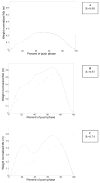Comparison between overground and dynamometer manual wheelchair propulsion
- PMID: 22085811
- PMCID: PMC5450157
- DOI: 10.1123/jab.28.4.412
Comparison between overground and dynamometer manual wheelchair propulsion
Abstract
Laboratory-based simulators afford many advantages for studying physiology and biomechanics; however, they may not perfectly mimic wheelchair propulsion over natural surfaces. The goal of this study was to compare kinetic and temporal parameters between propulsion overground on a tile surface and on a dynamometer. Twenty-four experienced manual wheelchair users propelled at a self-selected speed on smooth, level tile and a dynamometer while kinetic data were collected using an instrumented wheel. A Pearson correlation test was used to examine the relationship between propulsion variables obtained on the dynamometer and the overground condition. Ensemble resultant force and moment curves were compared using cross-correlation and qualitative analysis of curve shape. User biomechanics were correlated (R ranging from 0.41 to 0.83) between surfaces. Overall, findings suggest that although the dynamometer does not perfectly emulate overground propulsion, wheelchair users were consistent with the direction and amount of force applied, the time peak force was reached, push angle, and their stroke frequency between conditions.
Figures



Similar articles
-
Consequences of a cross slope on wheelchair handrim biomechanics.Arch Phys Med Rehabil. 2007 Jan;88(1):76-80. doi: 10.1016/j.apmr.2006.09.015. Arch Phys Med Rehabil. 2007. PMID: 17207679
-
Comparing handrim biomechanics for treadmill and overground wheelchair propulsion.Spinal Cord. 2011 Mar;49(3):457-62. doi: 10.1038/sc.2010.149. Epub 2010 Nov 2. Spinal Cord. 2011. PMID: 21042332 Free PMC article.
-
Stroke pattern and handrim biomechanics for level and uphill wheelchair propulsion at self-selected speeds.Arch Phys Med Rehabil. 2007 Jan;88(1):81-7. doi: 10.1016/j.apmr.2006.09.017. Arch Phys Med Rehabil. 2007. PMID: 17207680
-
Propulsion patterns and pushrim biomechanics in manual wheelchair propulsion.Arch Phys Med Rehabil. 2002 May;83(5):718-23. doi: 10.1053/apmr.2002.32455. Arch Phys Med Rehabil. 2002. PMID: 11994814
-
Scoping review of the rolling resistance testing methods and factors that impact manual wheelchairs.J Rehabil Assist Technol Eng. 2021 Jan 31;8:2055668320980300. doi: 10.1177/2055668320980300. eCollection 2021 Jan-Dec. J Rehabil Assist Technol Eng. 2021. PMID: 33598312 Free PMC article.
Cited by
-
How Was Studied the Effect of Manual Wheelchair Configuration on Propulsion Biomechanics: A Systematic Review on Methodologies.Front Rehabil Sci. 2022 May 2;3:863113. doi: 10.3389/fresc.2022.863113. eCollection 2022. Front Rehabil Sci. 2022. PMID: 36189035 Free PMC article.
-
Shoulder pain and time dependent structure in wheelchair propulsion variability.Med Eng Phys. 2016 Jul;38(7):648-655. doi: 10.1016/j.medengphy.2016.04.005. Epub 2016 Apr 25. Med Eng Phys. 2016. PMID: 27134151 Free PMC article.
-
The influence of wheelchair propulsion hand pattern on upper extremity muscle power and stress.J Biomech. 2016 Jun 14;49(9):1554-1561. doi: 10.1016/j.jbiomech.2016.03.031. Epub 2016 Mar 25. J Biomech. 2016. PMID: 27062591 Free PMC article.
-
Comparison of Manual Wheelchair and Pushrim-Activated Power-Assisted Wheelchair Propulsion Characteristics during Common Over-Ground Maneuvers.Sensors (Basel). 2021 Oct 22;21(21):7008. doi: 10.3390/s21217008. Sensors (Basel). 2021. PMID: 34770323 Free PMC article.
-
The influence of speed and grade on wheelchair propulsion hand pattern.Clin Biomech (Bristol). 2015 Nov;30(9):927-32. doi: 10.1016/j.clinbiomech.2015.07.007. Epub 2015 Jul 21. Clin Biomech (Bristol). 2015. PMID: 26228706 Free PMC article.
References
-
- Boninger ML, Koontz AM, Sisto SA, Dyson-Hudson TA, Chang M, Price R, Cooper RA. Push-rim biomechanics and injury prevention in spinal cord injury: Recommendations based on CULP-SCI investigations. Journal of Rehabilitation Research and Development. 2005;42:9–20. doi: 10.1682/JRRD.2004.08.0103. - DOI - PubMed
-
- Cooper RA, DiGiovine CP, Boninger ML, Shimada SD, Koontz AM, Baldwin MA. Filter frequency selection for manual wheelchair biomechanics. Journal of Rehabilitation Research and Development. 2002;39:323–336. - PubMed
-
- Cooper RA, Robertson RN, Van Sickle DP, Boninger ML, Shimada SD. Methods for determining three-dimensional wheelchair pushrim forces and moments: a technical note. Journal of Rehabilitation Research and Development. 1997;34:162–170. - PubMed
Publication types
MeSH terms
Grants and funding
LinkOut - more resources
Full Text Sources

